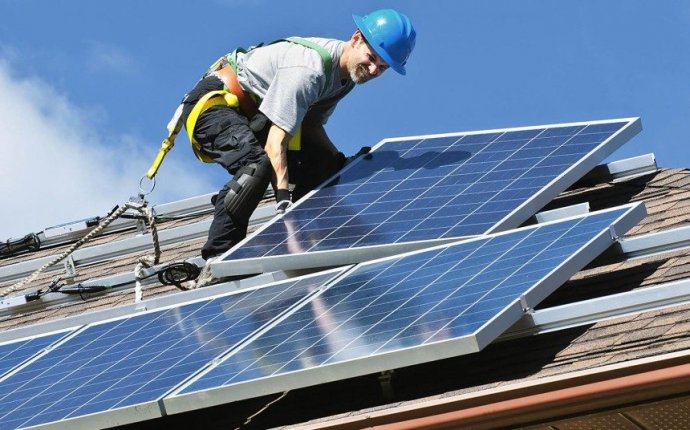
Electrical solar Panels
We can change sunlight directly to electricity using solar cells. Every day, light hits your roof's solar panels with photons (particles of sunlight). The solar panel converts those photons into electrons of direct current ("DC") electricity. The electrons flow out of the solar panel and into an inverter and other electrical safety devices. The inverter converts that "DC" power (commonly used in batteries) into alternating current or "AC" power. AC power is the kind of electrical that your television, computer, and toasters use when plugged into the wall outlet.
A net energy meter keeps track of the all the power your solar system produces. Any solar energy that you do not use simultaneous with production will go back into the electrical grid through the meter. At night or on cloudy days, when your system is not producing more than your building needs, you will consume electricity from the grid as normal. Your utility will bill you for the "net" consumption for any given billing period and provide you with a dollar credit for any excess during a given period. You can carry your bill credit forward for up to a year.
Solar Cells
Solar cells are small, square-shaped panel semiconductors made from silicon and other conductive materials, manufactured in thin film layers. When sunlight strikes a solar cell, chemical reactions release electrons, generating electric current. Solar cells are also called photovoltaic cells or "PV cells" and can be found on many small appliances such as calculators.
Solar Photovoltaic (PV) System Components
A PV system components include PV modules (groups of PV cells), which are commonly called PV panels; one or more batteries; a charge regulator or controller for a stand-alone system; an inverter to covert solar power from direct current (DC) to the alternating current (AC) of the utility grid-connected system; wiring; and mounting hardware or a framework. A PV module arranges individual PV cells, and the modules are grouped together in an array. Some of the arrays are set on special tracking devices to follow sunlight all day long and improve system efficiency.
PV System Installation, Maintenance, and Longevity
You could install a photovoltaic (PV) or solar electric system yourself. But to avoid complications or injury, you will probably want to hire a reputable professional contractor with experience installing solar systems. While they are sophisticated electric systems, PV systems have few moving parts, so they require little maintenance. The basic PV module (an interconnected, enclosed panel of PV cells) has no moving parts and can last more than 30 years while requiring little maintenance. The components are designed to meet strict dependability and durability standards to withstand the elements. The best way to ensure and extend the life and effectiveness of your PV system is by having it installed and maintained properly. Most PV system problems occur because of poor or sloppy system installation. Solar systems that receive rebates through California utilities are required to have a 10-year system warranty.
Incorporating PV Systems into Your Home and Business
PV systems today can be blended easily into both traditional and nontraditional homes, powering appliances and electric systems. PV cells can be installed as a stand-alone module that is attached to your roof or on a separate system, or using integrated roofing materials with dual functions - that as a regular roofing shingle and as a solar cell making electricity. The most common practice is to mount modules onto a south-facing roof or wall. PV systems likewise can be blended into virtually every conceivable structure for commercial buildings. You will find PV used outdoors for security lighting as well as in structures that serve as covers for parking lots and bus shelters.
Sunlight Requirements for PV Systems
A photovoltaic (PV) system needs unobstructed access to the sun's rays for most or all of the day to be effective. Shading on the system can significantly reduce energy output. Climate is not a major concern because PV systems are relatively unaffected by air temperatures, and snow cover typically melts quickly because panels are positioned directly into the sunlight. Abundant year-round sunshine makes solar energy systems useful and effective nearly everywhere in California.
The Size of Your Solar PV System
The size of your solar system depends on several factors such as how much electricity or hot water or space heat you use, the size of your roof, how much you're willing to invest, and how much energy you want to generate. Contact a system designer/installer to determine what type of system fits your needs or use one of the Go Solar California online calculators to determine what system size will offer you the best financial payback.
Other Solar Technologies
- Concentrating solar power (CSP) systems concentrate the sun's energy using reflective devices such as troughs or mirror panels to produce heat that is then used to generate electricity.
- Solar water heating systems contain a solar collector that faces the sun and either heats water directly or heats a "working fluid" that, in turn, is used to heat water. For more information on installing a solar water heating system, please see the CSI Solar Thermal section of the Go Solar California website.
- Transpired solar collectors, or "solar walls, " use solar energy to preheat ventilation air for a building.









